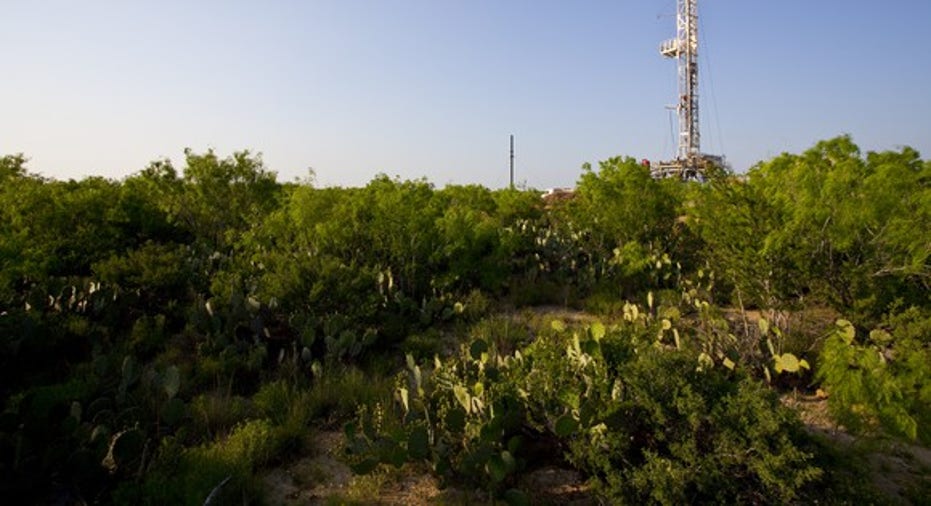The Biggest Texas Oil Fields Producing Today

Texas is the nation's largest oil-producing state, accounting for about 25% of the total. Fueling that output is a combination of legacy oil fields and new shale discoveries, especially those in the Permian Basin of west Texas, which alone contributes 14% of the total U.S. oil output.
While there are thousands of oil fields spread across the state, many don't produce that many barrels of oil each month. Instead, the bulk of the state's production comes from just two monster oil fields: the Permian Basin and the Eagle Ford shale. Here's a closer look at why these are the two largest oil-producing fields in the Lone Star state.
Image source: Getty Images.
The shale layer cake
According to the U.S. Energy Information Administration, the Permian Basin currently produces nearly 2.3 million barrels of oil per day, more than double what the field did a decade ago. That output comes from several producing fields and rock formations, the largest of which are the Spraberry and Wolfcamp trends:
Data source: EIA.
Those shale layers are also responsible for the bulk of Texas' oil production growth in recent years. Fueling that growth is the fact that oil saturates these rocks, which enables producers to extract it for a relatively low cost. The Spraberry and Wolfcamp, for example, contain an estimated 75 billion barrels of oil equivalent recoverable resource potential, according to Pioneer Natural Resources (NYSE: PXD), making it one of the largest oil fields in the entire world. However, what has proven to be a game changer for production in recent years is the move from drilling vertical wells to horizontal drilling, which, as the following chart shows, started in 2011:
Data source: Pioneer Natural Resources investor presentation.
The reason output surged is due to the stunning impact horizontal drilling has on production per well. A few years ago, Pioneer Natural Resources noted that a typical vertical well in the basin would produce 140,000 barrels of oil equivalent over its 30- to 35-year lifetime. However, with a horizontal well, Pioneer could do that in just six months.
Meanwhile, on the other side of the Permian Basin is the Delaware, which is home to the Bone Springs and Wolfcamp formations, which according to some estimates hold as many as 60 billion barrels of oil equivalent resources. Shale drillers EOG Resources (NYSE: EOG) and Devon Energy (NYSE: DVN) are among the many that have targeted those layers in recent years to drive production growth. EOG Resources drilled 17 Wolfcamp wells last quarter, which delivered an average initial production rate of nearly 1,600 barrels of oil per well. EOG estimates that it can drill more than 2,600 future wells in that formation alone, accessing as much as 2.9 billion barrels of oil equivalent resources. Devon Energy, meanwhile, is in the process of ramping up its drilling efforts into these layers, planning 100 more wells this year, which would grow its production 20% by the end of this year.
Image source: Anadarko Petroleum.
Down but not forgotten
Texas' other monster oil field is the Eagle Ford shale, which was only discovered in 2008. However, after delivering explosive production growth over the next several years, the play fell on hard times due to the oil market downturn. In fact, after peaking in 2015 at roughly 1.6 million barrels per day, the Eagle Ford's output is down to roughly 1.1 million barrels per day. That's after drillers like Pioneer Natural Resources stopped drilling in the play last year because of low oil prices, while EOG and Devon both cut back significantly.
However, that trend should reverse this year. Not only has Pioneer resumed its drilling program, but EOG and Devon plan to drill and complete more wells this year, though they all see the Permian fueling the bulk of their growth this year. Meanwhile, several other drillers are ramping up their Eagle Ford activities this year, includingSanchez Energy (NYSE: SN). Fueling Sanchez Energy's plan is its recent joint venture with a private equity giant to acquire Anadarko Petroleum's (NYSE: APC) underutilized Eagle Ford acreage for $2.3 billion. Sanchez intends to leverage its increased scale to ramp up drilling on the former Anadarko land, as well as its legacy acreage, anticipating 30% compound annual production growth over the next three years.
Meanwhile, as oil prices improve, other oil companies are likely to ramp up spending in the Eagle Ford. EOG, for instance, has more than 7,000 remaining drilling locations on its industry-leading land position.Meanwhile, Pioneer and Devon both hold large acreage position that they could develop or sell to other drillers that, like Sanchez, could use it as a springboard for production growth.
Investor takeaway
When it comes to oil fields, everything is bigger in Texas as the state controls not one but two of the largest producing oil fields in the country. What makes thesefieldsso large is that they hold a vast supply of low-cost oil, making it easy for drillers to maintain and grow production. Speaking of growth, with billions of barrels still in the ground, these monster fields should continue to produce for decades to come, enabling Texas to keep its crown as the country's top oil state.
10 stocks we like better than EOG ResourcesWhen investing geniuses David and Tom Gardner have a stock tip, it can pay to listen. After all, the newsletter they have run for over a decade, Motley Fool Stock Advisor, has tripled the market.*
David and Tom just revealed what they believe are the 10 best stocks for investors to buy right now... and EOG Resources wasn't one of them! That's right -- they think these 10 stocks are even better buys.
Click here to learn about these picks!
*Stock Advisor returns as of February 6, 2017
Matt DiLallo has no position in any stocks mentioned. The Motley Fool owns shares of Devon Energy and EOG Resources. The Motley Fool has a disclosure policy.



















